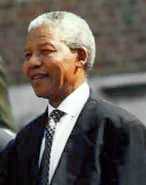President of South Africa
| President of the Republic of South Africa | |
|---|---|
 Seal of the President of South Africa | |
| Residence |
Mahlamba Ndlopfu (Pretoria) Genadendal (Cape Town) |
| Appointer | National Assembly of South Africa |
| Term length |
5 years renewable once |
| Inaugural holder | Nelson Mandela |
| Formation | 10 May 1994 |
| Deputy | Deputy President of South Africa |
| Website | www.thepresidency.gov.za |
| This article is part of a series on the politics and government of South Africa |
| Government |
|
|
|
The President of the Republic of South Africa is the head of state and head of government under the Constitution of South Africa. From 1961 to 1994, the head of state was called the State President.
The President is elected by the National Assembly, the lower house of Parliament, and is usually the leader of the largest party, which has been the African National Congress since the first non-racial elections were held on 27 April 1994. The role was originally founded to be distinct from the now defunct role of prime minister, but the two roles were merged in the 1983 constitution which specified a four-year term of office. The 1993 and later constitutions limits the president's time in office to two five-year terms.[1] The first President to be elected under the new constitution was Nelson Mandela, and the incumbent president is Jacob Zuma.
Under the interim Constitution (valid from 1994 to 1996), there was a Government of National Unity, in which an MP from the largest opposition party was entitled to a position as Deputy President. Along with Thabo Mbeki, the last State President, F.W. De Klerk also served as Deputy President, in his capacity as the leader of the National Party which was the second-largest party in the new Parliament. But De Klerk later resigned and went into opposition with his party. A voluntary coalition government continues to exist under the new constitution (adopted in 1996), although there have been no appointments of opposition politicians to the post of Deputy President.
The President is required to be a member of the National Assembly at the time of his election. Upon his election, he immediately resigns his seat for the duration of his term.
Electoral System
South Africa has a unique system for the election of its president. Unlike other former British colonies and dominions who have adopted a parliamentary republican form of government and those that follow the Westminster system, South Africa's President is both head of state and head of government and Commander-in-Chief of the South African National Defence Force (SANDF). Contrary to presidential systems around the world, the President of South Africa is elected by the Parliament of South Africa[2] rather than by the people directly or an Electoral College, thus answerable to it in theory and able to influence legislation in practice as head of the majority party (presently the ANC). The Constitution has thus prescribed a system combining both parliamentary and presidential systems in a unique manner.
Although the presidency is the key institution, it is hedged about with numerous checks and balances that prevent its total dominance over the government, as was the case in many African countries. The presidential term is five years, and he is limited to two consecutive terms. Thus the electoral system attempts (at least on paper) to prevent the accumulation of power in the president as was during Apartheid or in many other African countries.[3]
Presidential powers
- Head of State and Government of the Republic of South Africa
- Leader of the Cabinet
- Appoints ministers and members to the Cabinet
- Awards and confers the National Orders of the State
- Commander-in-Chief of the South African National Defence Force
- Appoints the Chief Justice, Deputy Chief Justice, President and Deputy President of the Supreme Court of Appeal.
- Must sign all acts of Parliament
- May declare war or peace
The President is addressed as "Your Excellency" or "Mr/Madam President" and referred to as "The Honourable (name)".
The official seat of the President are the Union Buildings in Pretoria and the Tuynhuys in Cape Town. His living residences are Mahlamba Ndlopfu in Pretoria and Genadendal in Cape Town.
List of Presidents of South Africa since 1994
- Parties
| # | Name (Born–Died) |
Picture | Took office | Left office | Elected (Parliament) |
Political Party |
|---|---|---|---|---|---|---|
| 1 | Nelson Mandela (1918–2013) |
 |
10 May 1994 | 16 June 1999 | 1994 (22nd) | African National Congress |
| 2 | Thabo Mbeki (1942–) |
 |
16 June 1999 | 24 September 2008 (Resigned) |
1999 (23rd) 2004 (24th) |
African National Congress |
| 3 | Kgalema Motlanthe (1949–) |
 |
25 September 2008 | 9 May 2009[4] | 2008 (24th) | African National Congress |
| 4 | Jacob Zuma (1942–) |
 |
9 May 2009[4] | Incumbent | 2009 (25th) | African National Congress |
Latest election
See also
- State President of South Africa
- Prime Minister of South Africa
- Governor-General of the Union of South Africa
- List of Presidents of the South African Republic (1857–1902)
- State President of the Orange Free State
- Freedom Day
References
External links
| Wikimedia Commons has media related to Presidents of South Africa. |
| |||||||||||||||||||||||||||||||||||||||||||||||||||||||
| |||||||||||||||||